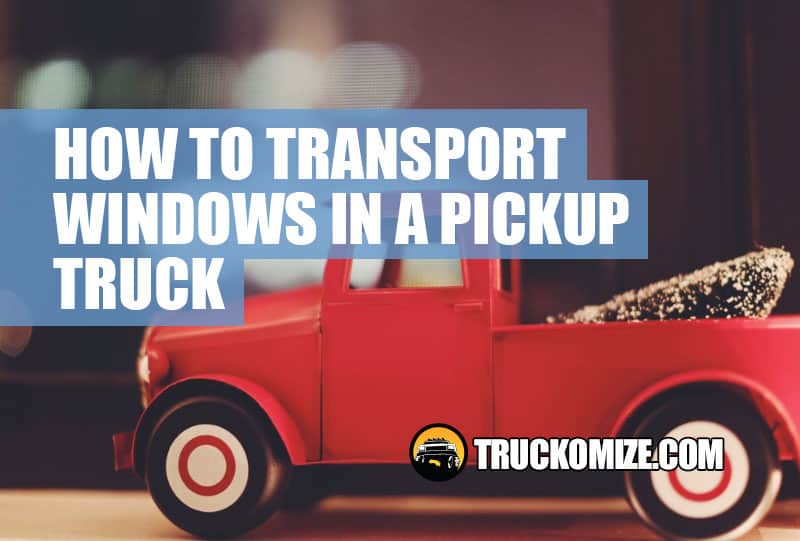What could be worse than buying a new set of windows, getting excited to pick them up, loading them incorrectly and then arriving home to the disappointment of broken glass and damaged frames? Not much, actually! That type of disappointment (and financial loss) can be hard to beat. Once you collect your new windows, they become your property and you cannot return them if you damage them on the way home. You can avoid the disappointing outcome of transporting windows incorrectly by brushing up on your window transportation knowledge and skills!
How to transport windows in a pickup truck in 5 easy steps:
- Use layers of sponge between each window. Single windows should be wrapped individually in stretch foil.
- Use a non-slip mat or material to deter slipping/sliding.
- Load the windows upright at a 45-degree angle.
- Use a wooden stillage for added security.
- Drive strategically to avoid damage.
Windows are fragile and most manufacturers and suppliers that offer delivery have specialized vehicles designed for transporting window frames and sheets of glass. When you hire one of these companies, delivery is safe and risk-free – not to mention stress-free too!
If you find yourself in a situation where you need to transport your windows yourself, you need to have a basic idea of what to do. It is probably a good idea to take out insurance cover on your windows for potential damage, before you actually collect them – make sure that transit damage is included. Read on to learn more on how to go about transporting windows in your own pickup truck safely.
5 Steps for Transporting Windows | DIY How to Transport Windows
If you are ready to collect your windows, you need to have a plan of action for getting them home. You cannot simply “wing it” and hope for the best.
Many people have tried and failed to protect their windows from damage along the way, but it does not have to be so complicated.
Forget everything you thought you knew about transporting windows. Just follow these simple steps and you should have a hassle-free experience.
1. Use layers of sponge between windows | wrap single windows with stretch foil
If you are transporting just one window, the risk is slightly less. When traveling with just one window, the best way to protect your window is to wrap it in stretch foil.
Why is using stretch foil a good idea? Stretch foil has high elasticity and is also highly durable.
Regular cling film simply cannot compare in terms of durability and strength.
When it is wrapped around the window, it will keep the window panes tightly bound and less prone to cracking or shattering when encountering a few bumps and rattles.
If you are carrying more than one window, you can wrap each window in stretch foil first, and then take a further preventative measure by layering sponge between each window. Once the sponge is in place, you can use straps to bundle the windows so that they now form one secure unit.
This reduces the risks of windows rattling or bumping next to each other which can lead to broken window panes.
Tightly secured windows (in a bundle) are easier to control on the back of the pickup truck.
2. Load windows upright at a 45-degree angle
How should the windows be loaded on the back of the pickup truck?
Most people agree that windows should never be stacked flat when being transported.
This is most likely due to personal experience – window panes and frames tend to break when transported while lying flat. The broader surface area of glass (and the frame) resting on the truck’s bed is far more vulnerable when the pickup truck goes over bumps and knocks – and sometimes a few bumps along the way simply cannot be avoided.
The vibration of a smooth drive can even prove damaging to a window that is transported while lying flat.
The best way to avoid potential damage is to stack the windows together at a 45-degree angle, upright. The 45-degree angle takes a lot of the stress off the window frame and also alleviates the vibration and pressure that would otherwise be exerted on the entire base that the window is resting on.
Windows stacked at 45-degree angles have less chance of breaking while on route.
3. Place a non-slip matt or material on the pickup truck bed
There’s always the possibility that items stacked on a pickup truck could slide or fall over the side of the truck. Even though you will probably secure the windows with straps to lessen these risks, you should take an extra precautionary measure by ensuring that the window has no chance to slip or slide during transport.
If your pickup truck does not already have a non-slip lining, you might want to provide you own version in the form of a mat. Non slip mats are a great way to completely minimize the potential movement of the windows and other materials being transported in your pickup truck.
Of course, you should place the non-slip mat in the truck before loading the windows. The non-slip functionality can greatly reduce risk in the event of an accident or the driver having to stop abruptly.
Usually in these instances, items on the back of the truck will fall, slide, or potentially fly off the back.
This is less likely to happen if you have a non-slip mat. You can have peace of mind that the windows will not slide out or fall over on impact.
4. Use a wooden stillage for added security
While your pickup truck is not typically designed for transporting glass and windows, it doesn’t mean that it can’t be. You can transform your pickup truck it into an almost-professional window transporting vehicle by simply placing a wooden stillage on the truck bed.
You will need to secure the stillage to the anchor points to make sure that it itself is not a safety hazard. What is a wooden stillage and where can you get one? A wooden stillage is used for pallet stacking and can be found in many warehouses and store rooms.
You can make your own stillage by affixing 2 pallets together.
To do this, use one pallet as a base and attach (with nails) the second pallet upright on the top and center or on the one side at the same 45-degree angle that you wish to stack the windows at. Why is a wooden stillage useful for transporting windows?
The stillage provides something for you to lean/stack the windows up against (as the windows will probably be taller than the sides of your pickup truck), but that is not all.
The pallets also provide something for you to secure the windows too. Otherwise using ratchet straps can work to hold your windows in place, but the stillage provides more opportunity for strapping and securing the units.
5. Drive strategically to avoid damage
Regardless of how far you are traveling, plan to slow things down a little and be extra cautious on the road when transporting windows. The slightest of impacts can result in your windows breaking.
How you drive will have an impact on the condition of your windows when you arrive at your destination. If you drive fast and connect with every bump and pothole, you are at a greater chance of the window panes breaking and the frames becoming chipped and damaged.
Before you transport the windows, make sure that you choose the best possible route in terms of smoothness and traffic. You do not want to take a regular route only to find that it is very bumpy along the way. This will result in stress and even potential damage.
Much the same, if you choose a very busy route, you might not be too popular if you have to hold up traffic by driving slowly or if you need to stop to make adjustments to your load.
Sometimes things shift around when the pickup truck is moving so it’s best to keep possible adjustments in mind.
It is also a good idea to take someone with you to provide a helping hand if you encounter some problems on the road or if you need to shift things around on the back of your truck while on route.
Conclusion
While some people might believe that the best way to transport windows is to hire a professional transportation service (or ask the manufacturer of the windows to arrange delivery), others know that it can actually be done DIY quite simply.
By observing the above tips and advice on how to transport windows in a pickup truck, there is no reason that you cannot arrange to move your windows alone quite successfully.
All you need to do is take a few precautions to safeguard against potential damage.
The best word of advice that anyone can heed is to never overload the pickup truck and to ensure that the windows will not move anywhere while being transported.


